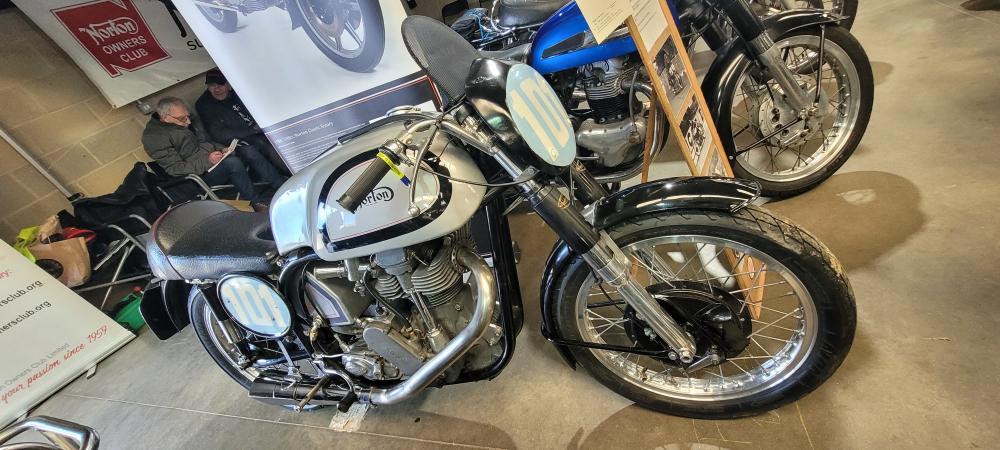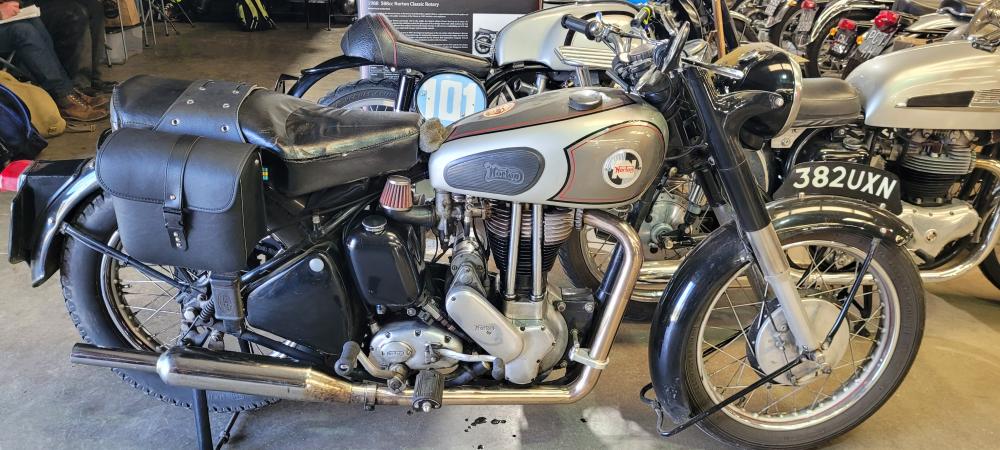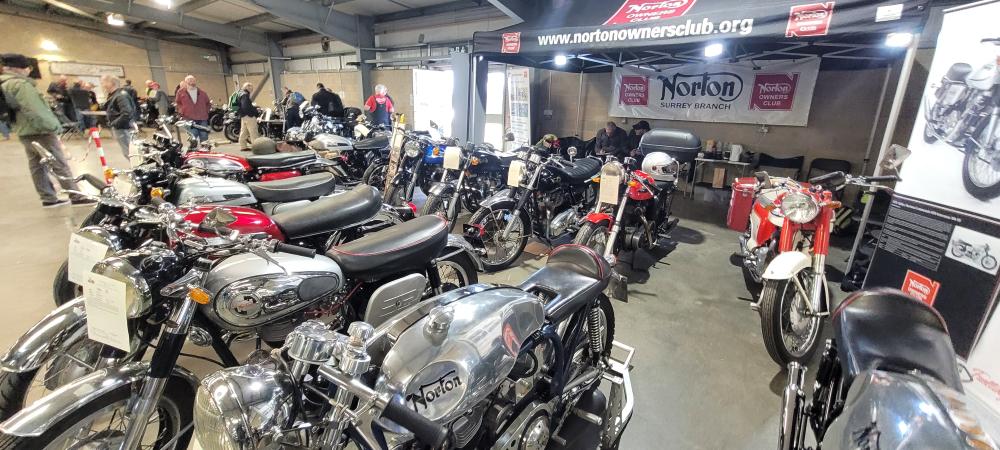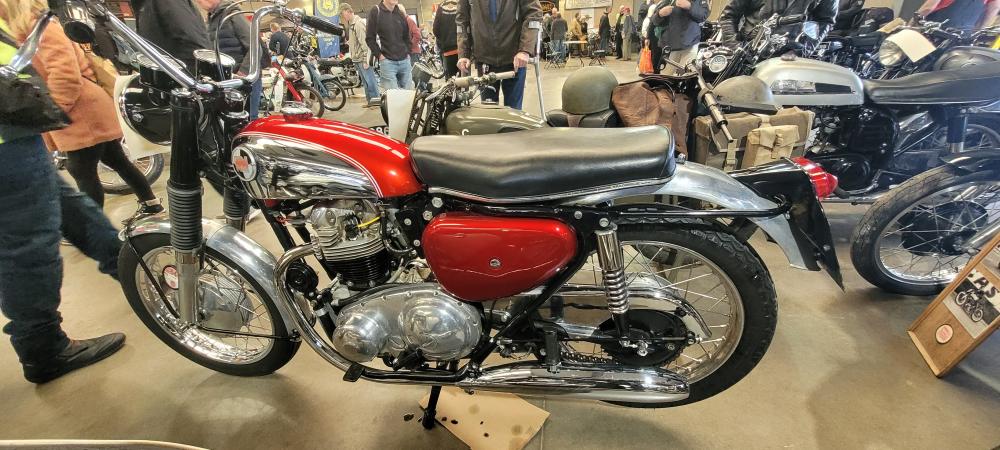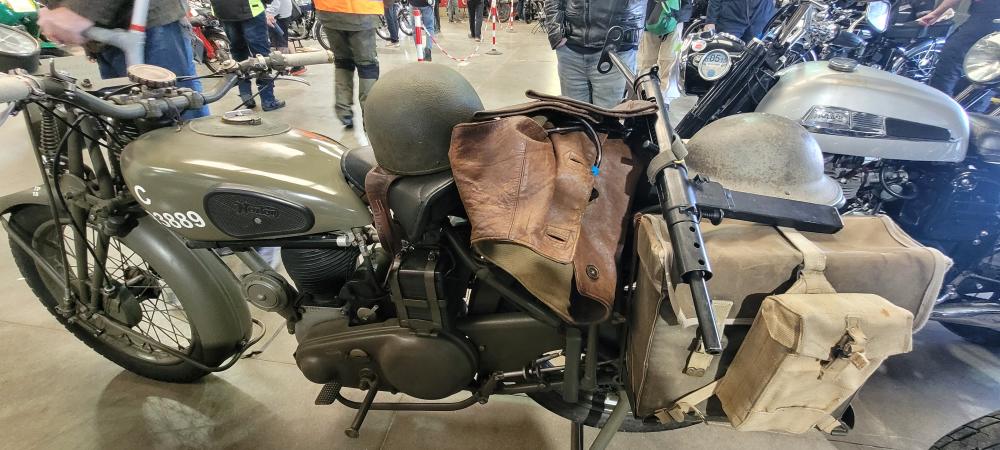A review of correspondence from NOC-L
A review of postings on balancing crankshafts, particularly with reference to installing Commando engines in Featherbed frames and ideas for 76o and 90o crankshafts
90 degree Norton crankshaft questions
I have considered building a 90o degree Norton crank using the existing journals bolted to a new self made flywheel. I will have to cut and rotate one half of the camshaft 45o and modify the Boyer pick up plate and/or magnet rotor as well.
One person (Brian Tyree) has already gone this route, and another with a 60o crank. The reason for 90o and not 180o is that when the pistons reach t.d.c. or b.t.c. they want to stop. With a 90o crank, one piston is nearly at its maximum speed and this stopping action will be reduced (Phil Vincent suggests 76o, but this depends on the stroke of the engine, when the rod is at right angles to the crank).
An added bonus is that all the secondary forces are cancelled out (they occur at twice crankshaft revs in different directions with a 90o crank). Yes I know there will be some rocking couples, but I don't even know where to start in cancelling them out, but I'm sure they are a lot less that a 750/830/920 parallel twin!
I am thinking of a balance factor of 50% and the engine will be mounted in a Featherbed frame; the isolastics only work in a one directional plane (up/down front/back) not with rocking couples.
John Martin (john.martin@fluordaniel.com) on NOC-L 29th. Apr 1997
76 degree vs. 90 degree crankshaft
Check out the February 1992 issue of Classic Motor Cycle, there is an article there about a 76o Triumph with a Norton crank. The article suggests that 90o would be a better choice.
Peter Martin (pmartin@che2.che.umn.edu) on NOC-L 30th. Apr 1997
Comments on 76 degree crankshaft conversion by its owner
| Dick Cookson's 76o crank conversion for his 500cc Triumph was featured in the April 1994 copy of Classic Bike. I recently contacted Dick and urged him to join the Brit-Iron list. Here is his very interesting reply:- |
I am pleased to hear that my 76o crank conversion has caused so much interest. The 90o Norton Story by Brian Tyree and technical observations of Professor Sergio Montes, gives me a starting point.
The history behind my own crank modification began with an article in the Classic Motor Cycle, The V-twin Triumph. Here was a Triumph put right by would you believe it, Phil Irving, via another forthright Australian, Lee Kernich. Simply set the crank angle at 76o, drastically reduce fly-wheel weight, and you have a much more responsive and smooth engine. But if it's so simple why hasn't it been done before? Why in all the writings soaked up by all the motor cycle nuts had there been no clue? Or perhaps I had missed something. A collected volume of Slide Rule (i.e. Phil Irving's articles re-printed from Motor Cycling), the articles of l7th June 1943 and 8th July 1943, seemed a good place to start. I could perhaps be excused for having missed them first time round, being only 3 years old at the time.
|
Slide Rule reports:- "During lively discussions which followed Mr. Turner's paper on post- war Motorcycle Development read before the Institute of Automobile Engineers the subject of engine balance came up for a marked degree of attention particularly with regard to the relative merits of the single cylinder and parallel twin varieties." |
So Edward Turner was already fending off critics of his 360o twin released so successfully only 6 years earlier. Good acceleration, neat appearance, even firing and cheap cost through ease of manufacture may have been a good sales pitch in 1937 when British roads were more bends than straights, but would the concept be right for postwar years when roads might improve? And what about overseas? Rapidly getting back to basics, Irving pointed out that as regards balance, a twin was simply two singles put together. With a single it was possible to balance completely the big end and lower part of the conrod, since they follow a continuous path with the flywheel, by adding equal weight to the opposite side of the flywheel. The upper part of the conrod and piston assembly however, exert only intermittent forces; i.e. as the piston thrusts up to t.d.c. or down to b.d.c. At the halfway 90o positions there were no such primary forces. If the primaries at the t.d.c/b.d.c. positions were balanced 100%, the additional weight would itself create imbalance at the 90o positions; a compromise percentage was necessary, the balance factor. The remaining percentage would inevitably transmit vibrations to the crank assembly as the piston hit t.d.c. and b.d.c.
In a 360o twin, Irving said, the balance arrangements were no better than a single of the same overall capacity since both pistons hit t.d.c and b.d.c. together. The only possible improvement for the twin was having light conrods, i.e. both weighing less than one rod for the single. Irving was quick to point out that vibration was also caused by bending in the crank at t.d.c. and b.d.c. as the conrods pulled or pushed on the crankpin. The shorter the unsupported length of the crank the better. In a Triumph twin with the mains some 6 inches apart, the prospects for bending were rather good. Some improvement could be had from careful positioning of the balance weights but the basic position was poor (as opposed to the Velocette single,where the mains are very close together). At that time (1943 don't forget) Irving recognised that the principle justification for the 360o twin was to provide even firing. To exchange the one big bang of a single for two smaller ones, spaced at regular intervals. This would smooth out firing torque but do nothing for imbalance or crankshaft flexing. Irving was careful to explain that a second cylinder could be added in such a way that the primary imbalance of one cylinder would completely cancelled by the other, e.g. a 180o twin or flat twin.
Moving on to 1961 and dusting off our copy of Irving's Motor Cycle Engineering of that year, we find him conceding that the Triumph type twin has been successful up to a point. We also find him, at this point, going into fairly great depth on the piston acceleration theme. Assume a 4:1 rod to crank ratio; he said it will be found that maximum piston speed is achieved at 76o before and after t.d.c. For the first 10o of rotation after t.d.c. the piston moves only a fraction. The next 10o produces more movement, the next 10o degrees even more and so on until the crank and rod are at right angles to each other at which point the piston is going at maximum speed. At this position the engine has achieved 76o degrees of rotation after t.d.c. Thereafter as the rod and crank turn, the piston slows down until it reaches b.d.c.
Irving was very quick to point out that this fact greatly assisted the V-twin in that with both rods operating from the same crank pin when one piston was at t.d.c., the other was inevitably in the mid-stroke position and travelling at or near maximum speed. Irving takes the opportunity at this point to point demonstrate that the 76o factor also accounts for the concentration of forces into the upper arc of rotation.The effect of this was to add 25% to the inertia forces at t.d.c.,and to subtract 25% at b.d.c. The 25% was also active at midstroke positions, these modifications being identified as secondary forces. There was, he said, no hope of balancing out these secondary forces in a single or 360o twin, even partially. Any balance weight added to counter the affect at t.d.c. would make matters worse at b.d.c.
In fact the only twin in current use where the secondaries of one cylinder would be balanced by secondaries in the other was a flat twin, which for fairly obvious reasons has one cylinder balancing out completely all the out of balance forces in the other. The 180o parallel twin whilst balancing completely the primaries, left the secondaries completely unbalanced. Not only that, but the 180o twin had a severe rocking couple whereby as the crankpins alternate positions at t.d.c. and b.d.c., the whole engine was induced to rock from side to side. The severity of this resulted from the unavoidable wide spacing of the crankpins. Irving was keen to point out that V-twins were relatively free from rocking couples owing to the pistons not reaching ends of the stroke at the same time and by not having widely spaced crankpins. Secondary forces were a problem in V-twins, however a compromise was necessary between secondary and primary forces. He favoured a 50o arrangement as on the Vincent twin (whereas Ducati for example selected 90o.
|
On to Irving's 1962 article as reprinted in Classic Motor Cycle of February 1992. By 1962 Honda had successfully introduced their 180o parallel twins, breaking the 25 year old fetish of 360o and even firing .Irving felt that here was a golden opportunity to go for it. If parallel twins were still the order of the day, why not combine as many positive features as possible into one design? This was easy for him as he had been thinking about for years. Fix the crank at 76o, he said, and you immediately have the V-twin flywheel effect, and at the maximum value. Not far behind, you would have the near perfect arrangement for cancelling out the secondary forces (90o would be best). The rocking couple would be slight as compared with the 180o vertical twin. Primary balance, whilst not as good as the 180o twin, would be considerably better than the 360o twin and firing would be more even than with the 180o twin. |
All in all he felt that the 76o crank would obtain the optimum result and supplied the relevant figures to support his views. He felt that the benefits would become more apparent on a larger engine but made no mention of crankshaft flex, surprisingly so in view of his earlier bangings on about the 360o twin. This aspect might be difficult to qualify but it seems fairly safe to assume that with a long Triumph type crankshaft, once the pistons do not hit t.d.c. and b.d.c. together, flex will be much reduced. Also, if a lighter flywheel is used, any remaining flex will not be amplified to the same extent. Irving felt that the 76o parallel twin was in urgent need of a test. In fact he approached major factories but no one, apparently, was interested. This is astonishing, especially since it only involved repositioning existing components - easy for a factory.
|
If Triumph had been approached it is possible that Edward Turner, who was still very much alive and kicking at this point, would have felt needled that an erstwhile competitor and critic on the British motor cycle scene was tinkering with his work. He was also resentful of academics as referred to in Steve Wilson's marvellous series of books British Motor Cycles Since 1950. In 1962, do not forget that the 650cc Bonneville was selling like hot cakes, the Honda 750 four was 6 years in the future and the Ducati V-twin 8 years. It is also puzzling why Irving himself didn't do it or persuade an Aussie friend to have a go; Irving had returned to Australia in the mid fifties. Perhaps he was just too busy. He was at that time taking a deep interest in tuning the Aussie Holden car engine,a version of which, as the Repco Brabham, powered Jack Brabham then Dennie Hulme to Formula 1 World Championships in 1966 and 1967. Irving had been the designer. |
Having a stock of second hand unit 500 spares I contrived a 76o crank after sawing in half a standard Triumph crank in such a way that after machining, each half would be a shrink fit in a new central flywheel. Bolts were added for security and balancing was achieved by removing metal from the area between the crankpins. Overall the flywheel weight was reduced to one third of the original Triumph unit, an important point being all the balance being held in each outer web, i.e. offset by 76o, a point not mentioned in any of Irving's papers. New camshafts were made by cutting standard Triumph cams in two and sleeving together each camshaft half at the appropriate positions. Twin contact breaker ignition enabled the sparks to be reset. The engine modifications took some ten months of careful planing ,machining and development.
All this theory is OK as a an academic exercise but did it work? Yes. Road testers of the picky types found that the following changes had been obtained by the 76o crank conversion. The bike was more responsive, more so than a standard Triumph; the bike would just stomp away, with no heavy flywheel to get going . Overall gearing was much higher than standard but this was no problem, the bike just pulled away without the need for a lot of revs, even uphill.
Neither was the engine lumpy. They found the bike a lot smoother than any Triumph they had ridden before, in particular the total absence of that high frequency tingle normally associated with British parallel twins. For myself the project has proved to be one of the most rewarding I have ever undertaken, I now have a bike as flickable as a 250 but with the acceleration, hillclimbing, and cruising ability of a fairly large V-twin.
It's uncanny, I can almost feel Phil Irving peering over my shoulder.Who could forget him ? And what about Edward Turner - he's sticking his nose in there somewhere.
Dick Cookson via John Pinkham (john@swmerc.rain.com) via Brit-Iron 25th. Nov 1994
Featherbed Commando balanced to 52%
Having finally got the 750cc Commando engined Featherbed vintage racer finished, I have the following observations to state. The Featherbed handling is far superior to the Commando, (even with a Norvil headsteady). The vibration level is nearly intolerable at 6500 - 7000 r.p.m. but the engine still has the Commando balance factor of 52%, not the 84%[?] of the Atlas. The 90 degree crankshaft seems even more inviting now; the best of both worlds.
John Martin (john.martin@fluordaniel.com) on NOC-L 12th. May 1997
Featherbed Commando balanced to 77%
I have a 750cc Commando motor in a Wideline Featherbed frame. The motor was rebalanced at 77% prior to buildup. I am running the bike in its 2nd. season, and last week ran the revs up to 6800 r.p.m.. Yes, it was a bit buzzy, but not much more than a standard Triumph twin in the same rev band. You will never get it to run as smooth as an isolastic setup, but hey, its a rigid mount!. I am not at all displeased with the motor performance!
Mike Andrusiewicz (mandrusi@pogo.den.mmc.com) on NOC-L 13th. May 1997
Featherbed Commando should be balanced to ca. 70%
Go for a 70% balance factor à la 650SS. This recommendation is from John Hudson of the NOC. The 52% balance factor will likely break everything on the bike if you leave it that way. The best thing would be to have the crank dynamically balanced for smooth running at the speed you want to use it most; this may vary from the 70% quoted. If you can't afford that, then balance it statically.
Colin R. Sharpe (colin@interaccess.com) on NOC-L 14th. May 1997
Pistons, rods etc. should be matched for good engine balance
Lots of interesting chat about balance factors and rigid mounting of Commando engines. As someone has already stated, the 52% balance factor mandates isolastic mounting. This is because most of the vibration produced at that factor is (purposely) in the vertical plane ... that is, in line with the resilience of the Iso rubbers. Mounting such an engine rigidly will couple a nasty bit of frame-breaking vibration into the works! I can't possibly fathom anyone doing this for long.
As for the choice of 77% in Mike's Wideline Commando .... it was chosen by the engine's tuner, the late Thomas G. Pope (a good friend, and a craftsman of no mean achievement!). He advised that we build it to that factor, based on his experience with the frame and engine combination. Consequently, we had it dynamically balanced to 77% after otherwise preparing the crank.
It is true, as others have said, that the optimal balance factor is also dependent on the frame design, and the predominant engine speeds being contemplated.... no real solution here other than experience. I'm a long term fan of dynamic balancing, having first enjoyed its benefits exactly 30 years ago this month, when I rebuilt my first 'good' bike; my faithful 1953 Royal Enfield 350 Bullet. The transformation was astounding. Interesting also to note that Royal Enfield twins were dynamically balanced from the factory, which explains their remarkable smoothness without use of rubber mounting etc.
I'd suggest that there is one other factor to consider, aside from the absolute 'number' chosen ... and that is getting both sides of a twin absolutely identical... which occurs implicitly during the preparation of an engine for balancing. Piston weights, rod weights end-to-end, gudgeon pins, etc. should be the same on each side for best results. The best (though extreme) anecdote I can give is of my friend Bob's BSA Firebird ... I had never in my life experienced a more evil machine for vibration. I couldn't bear to ride it for more than 10 minutes at any speed. When we stripped the engine, we found that at least some of the problem was due to mismatched rods ... at some point, the left side had blown, and so the cheap DPO had ground the one journal, and replaced the rod and piston with an earlier (lighter) style. Consider the rocking couples that were generated because of that mismatch!
Greg Kricorissian (grkricor@ccs.carleton.ca) on NOC-L 16th. May 1997
Piston weight affects engine balance
I've been following this thread with interest since I have an Atlas that vibrates more than it should at Highway speeds. I t's OK above 70 m.p.h. in high gear but it's hard to ride that fast at all times. It used to be fine before I blew a piston and replaced the pair with some Australian pistons that were heavier. This had the effect of lowering the balance factor and raising the r.p.m. of the 'sweet spot'.
I'm seriously considering replacing the pistons with lighter Hepolites as they are currently available. For what its worth, when I built my G15 motor I balanced it to 72% after going through the notes of the local dealer's father. He had kept records of every engine he ever built and the frame into which it went and what the vibration characteristics were. The G15 vibrated like mad till I got the carburettors jetted properly; since then it's nice and smooth at all r.p.m., much less vibration than the Atlas ever had.
Thomas H. Allen (thomasa@halcyon.com) on NOC-L 27th. May 1997
More on balancing to 77%
From what I understand, a Commando is balanced at 54% stock. An Atlas is balanced at 85% stock. My 750 Commando motor was balanced to 77%. My frame is a 1956 Wideline (welded), and the motor is canted forward (as in a stock Commando) but mounted rigidly (no isolastics). The engine had some mild porting done, and runs a single 34mm Mikuni. It idles like a clock at 900 r.p.m., pulls very hard starting at 2500 r.p.m. up to 7000 (where I stop revving). It will certainly rev higher than that.
The bike gets quite buzzy at 3200 r.p.m. or so (but no more than my old 750 Triumph). If running at 4000 r.p.m. (cruising speed), the buzzing is noticeable, but not annoying (I also run clip-ons). All in all, quite a nice ride. For two complete seasons now, nothing has vibrated loose or fallen off (knock on wood!). On this basis I would say 77% is a good balance number to use in a rigid mount. If mounting in a stock Commando frame, I would stay with the stock number; in general, I figure the factory chose this factor for a reason, so why second guess them? Verify the stock balance factor number for your bike and balance to that.
Mike J Andrusiewicz (mandrusi@pogo.ast.lmco.com) on NOC-L 30th. Dec 1997

